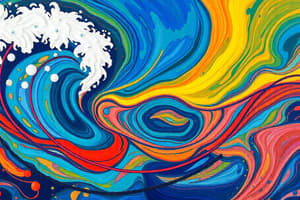Podcast
Questions and Answers
What generates ocean currents?
What generates ocean currents?
- Wind, the Coriolis effect, and temperature only
- Wind and salinity differences only
- Wind, waves, and temperature only
- Wind, the Coriolis effect, waves, temperature, and salinity differences (correct)
What is the global conveyor belt?
What is the global conveyor belt?
- A type of ocean current that moves horizontally
- A type of ocean current that moves vertically
- A system of ocean currents that plays a dominant role in determining Earth's climate (correct)
- A type of boat used for shipping goods across the ocean
What are the Gulf Stream and the Humboldt Current examples of?
What are the Gulf Stream and the Humboldt Current examples of?
- Surface ocean currents
- Global density gradients
- Warm and cold currents, respectively (correct)
- Deep ocean currents
What are the two basic types of ocean currents?
What are the two basic types of ocean currents?
How are ocean currents measured?
How are ocean currents measured?
What drives surface ocean currents?
What drives surface ocean currents?
What drives deep ocean currents?
What drives deep ocean currents?
What is the thermohaline circulation?
What is the thermohaline circulation?
Why are ocean currents important in the study of marine debris?
Why are ocean currents important in the study of marine debris?
Flashcards
What causes ocean currents?
What causes ocean currents?
Ocean currents are driven by various forces, including wind, the Coriolis effect, waves, temperature, and salinity differences.
What is the global conveyor belt?
What is the global conveyor belt?
The global conveyor belt is a large-scale system of ocean currents that circulates water throughout the world's oceans.
What are warm and cold currents examples of?
What are warm and cold currents examples of?
Warm currents, like the Gulf Stream, bring warmer water to higher latitudes, while cold currents, like the Humboldt Current, bring colder water towards the equator.
What are the basic types of ocean currents?
What are the basic types of ocean currents?
Signup and view all the flashcards
How are ocean currents measured?
How are ocean currents measured?
Signup and view all the flashcards
What drives surface ocean currents?
What drives surface ocean currents?
Signup and view all the flashcards
What drives deep ocean currents?
What drives deep ocean currents?
Signup and view all the flashcards
What is the thermohaline circulation?
What is the thermohaline circulation?
Signup and view all the flashcards
Why are ocean currents important in the study of marine debris?
Why are ocean currents important in the study of marine debris?
Signup and view all the flashcards
Study Notes
Ocean Currents: A Summary
- Ocean currents are directed movements of seawater generated by various forces, including wind, the Coriolis effect, waves, temperature, and salinity differences.
- Ocean currents primarily move horizontally, flow for great distances, and create the global conveyor belt, which plays a dominant role in determining Earth's climate.
- The Gulf Stream and the Humboldt Current are examples of how warm and cold currents, respectively, influence the temperature of the regions through which they travel.
- Surface and deep-water currents are the two basic types of currents that help define the character and flow of ocean waters across the planet.
- Ocean dynamics define and describe the motion of water within the oceans, and ocean currents are measured in units of sverdrup (sv) and meters per second (m/s) or knots.
- Surface ocean currents make up only 8% of all water in the ocean and are driven by wind currents, which are also influenced by the Coriolis effect.
- Deep ocean currents are driven by density and temperature gradients and are part of the large-scale ocean circulation known as the thermohaline circulation or the ocean's conveyor belt.
- The thermohaline circulation is driven by global density gradients created by surface heat and freshwater fluxes and has a large impact on Earth's climate.
- Ocean currents are distributed across the Arctic, Atlantic, Indian, Pacific, and Southern oceans and form gyres.
- Ocean currents are important in the study of marine debris, affect temperatures throughout the world, and play a decisive role in influencing the climates of regions through which they flow.
- Cold ocean water currents bring in a lot of plankton that are crucial to the continued survival of several key sea creature species in marine ecosystems.
- Knowledge of surface ocean currents is essential in reducing shipping costs and is also important for wind-powered sailing ships and marine power generation.
Studying That Suits You
Use AI to generate personalized quizzes and flashcards to suit your learning preferences.




